2015 MITSUBISHI OUTLANDER SPORT air filter
[x] Cancel search: air filterPage 235 of 384
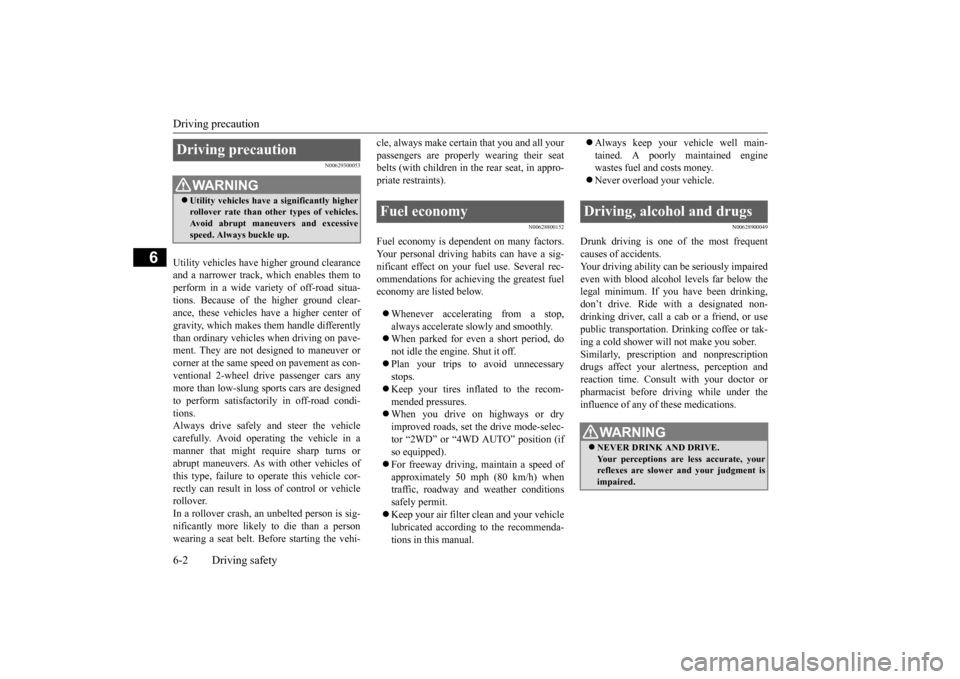
Driving precaution 6-2 Driving safety
6
N00629300053
Utility vehicles have higher ground clearance and a narrower track, which enables them toperform in a wide variety of off-road situa- tions. Because of the higher ground clear- ance, these vehicles have a higher center ofgravity, which makes them handle differently than ordinary vehicles when driving on pave- ment. They are not designed to maneuver orcorner at the same speed on pavement as con- ventional 2-wheel drive passenger cars any more than low-slung sports cars are designedto perform satisfactorily in off-road condi- tions. Always drive safely and steer the vehiclecarefully. Avoid operating the vehicle in a manner that might require sharp turns or abrupt maneuvers. As with other vehicles ofthis type, failure to operate this vehicle cor- rectly can result in loss of control or vehicle rollover.In a rollover crash, an unbelted person is sig- nificantly more likely to die than a person wearing a seat belt. Before starting the vehi-
cle, always make certain that you and all your passengers are properly wearing their seat belts (with children in the rear seat, in appro- priate restraints).
N00628800152
Fuel economy is dependent on many factors.Your personal driving habits can have a sig-nificant effect on your fuel use. Several rec-ommendations for achieving the greatest fuel economy are listed below. Whenever accelerating from a stop, always accelerate slowly and smoothly. When parked for even a short period, do not idle the engine. Shut it off. Plan your trips to avoid unnecessary stops. Keep your tires inflated to the recom- mended pressures. When you drive on highways or dry improved roads, set the drive mode-selec- tor “2WD” or “4WD AUTO” position (ifso equipped). For freeway driving, maintain a speed of approximately 50 mph (80 km/h) whentraffic, roadway and weather conditions safely permit. Keep your air filter clean and your vehicle lubricated according to the recommenda- tions in this manual.
Always keep your vehicle well main- tained. A poorly maintained engine wastes fuel and costs money. Never overload your vehicle.
N00628900049
Drunk driving is one of the most frequent causes of accidents.Your driving ability can be seriously impairedeven with blood alcohol levels far below the legal minimum. If you have been drinking, don’t drive. Ride with a designated non-drinking driver, call a cab or a friend, or use public transportation. Drinking coffee or tak- ing a cold shower will not make you sober.Similarly, prescription and nonprescription drugs affect your alertness, perception and reaction time. Consult with your doctor orpharmacist before driving while under the influence of any of these medications.
Driving precaution
WA R N I N G Utility vehicles have
a significantly higher
rollover rate than other types of vehicles. Avoid abrupt maneuvers and excessive speed. Always buckle up.
Fuel economy
Driving, alcohol and drugs
WA R N I N G NEVER DRINK AND DRIVE. Your perceptions are less accurate, your reflexes are slower and your judgment is impaired.
BK0206700US.bo
ok 2 ページ 2014年3月25日 火曜日 午後4時42分
Page 272 of 384
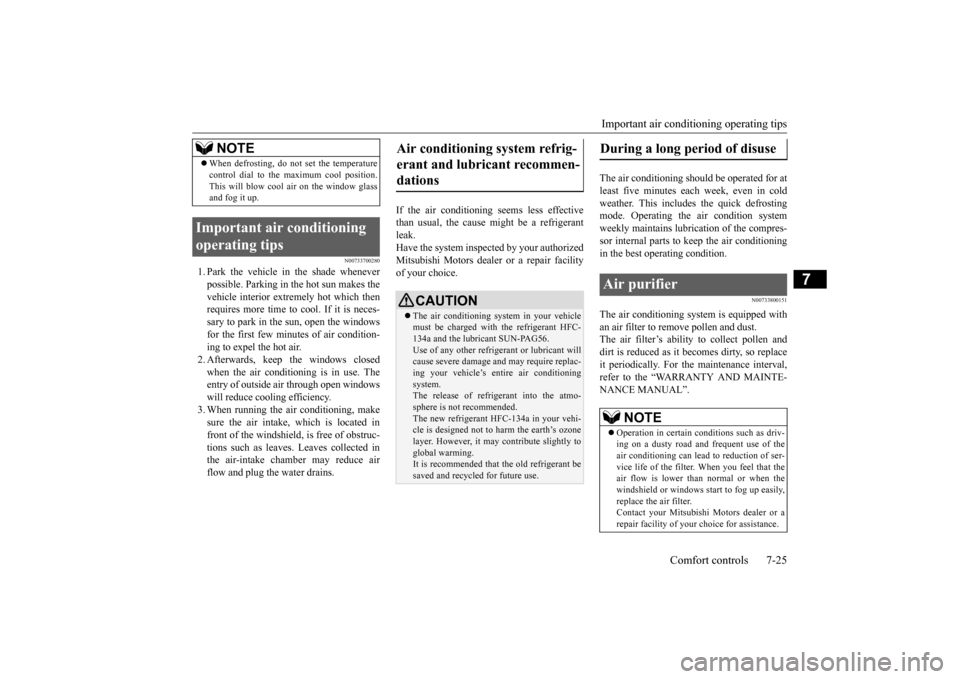
Important air conditioning operating tips
Comfort controls 7-25
7
N00733700280
1. Park the vehicle in the shade whenever possible. Parking in the hot sun makes the vehicle interior extremely hot which then requires more time to cool. If it is neces-sary to park in the sun, open the windows for the first few minutes of air condition- ing to expel the hot air.2. Afterwards, keep the windows closed when the air conditioning is in use. The entry of outside air through open windowswill reduce cooling efficiency. 3. When running the air conditioning, make sure the air intake, which is located infront of the windshield, is free of obstruc- tions such as leaves. Leaves collected in the air-intake chamber may reduce airflow and plug the water drains.
If the air conditioning seems less effective than usual, the cause might be a refrigerant leak.Have the system inspected by your authorized Mitsubishi Motors dealer or a repair facility of your choice.
The air conditioning should be operated for at least five minutes each week, even in coldweather. This includes the quick defrosting mode. Operating the air condition system weekly maintains lubrication of the compres-sor internal parts to keep the air conditioning in the best operating condition.
N00733800151
The air conditioning system is equipped with an air filter to remove pollen and dust. The air filter’s ability to collect pollen and dirt is reduced as it becomes dirty, so replaceit periodically. For the maintenance interval, refer to the “WARRANTY AND MAINTE- NANCE MANUAL”.
When defrosting, do not set the temperature control dial to the maximum cool position. This will blow cool air on the window glass and fog it up.
Important air conditioning operating tips
NOTE
Air conditioning system refrig- erant and lubricant recommen- dations
CAUTION The air conditioning system in your vehicle must be charged with the refrigerant HFC-134a and the lubricant SUN-PAG56. Use of any other refrigerant or lubricant will cause severe damage and may require replac-ing your vehicle’s entire air conditioning system. The release of refrigerant into the atmo-sphere is not recommended. The new refrigerant HFC-134a in your vehi- cle is designed not to harm the earth’s ozonelayer. However, it may contribute slightly to global warming. It is recommended that the old refrigerant be saved and recycled for future use.
During a long period of disuse Air purifier
NOTE
Operation in certain conditions such as driv- ing on a dusty road and frequent use of the air conditioning can lead to reduction of ser- vice life of the filter.
When you feel that the
air flow is lower than normal or when thewindshield or windows start to fog up easily, replace the air filter. Contact your Mitsubishi Motors dealer or arepair facility of your choice for assistance.
BK0206700US.bo
ok 25 ページ 2014年3月25日 火曜日 午後4時42分
Page 324 of 384
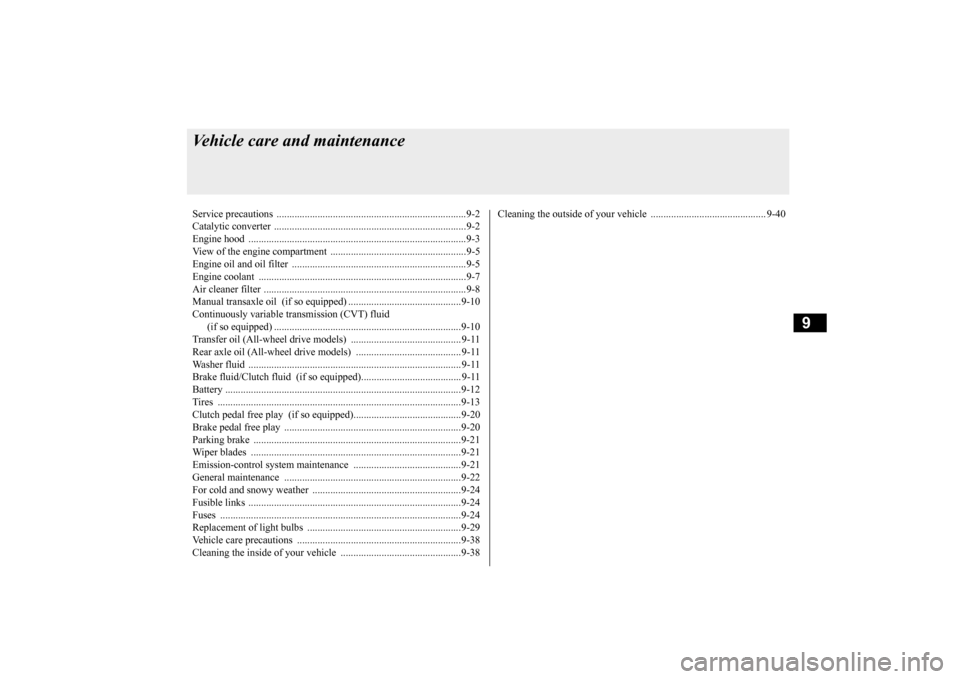
9
Vehicle care and maintenanceService precautions .........
.................................................................9-2
Catalytic converter
.................................................
..........................9-2
Engine hood ..............................
.......................................................9-3
View of the engine comp
artment .....................................................9-5
Engine oil and oil filt
er ................................
....................................9-5
Engine coolant ................
.................................................................9-7
Air cleaner filter ....
.................................................
..........................9-8
Manual transaxle oil (if so
equipped) ............................................9-10
Continuously variable transmission (CVT) fluid (if so equipped)
.................................................
........................9-10
Transfer oil (All-wheel dr
ive models) ........................................... 9-11
Rear axle oil (All-wheel dr
ive models) ......................................... 9-11
Washer fluid ....................
............................................................... 9-11
Brake fluid/Clutch fluid (if so equipped)....................................... 9-11 Battery .......................................
.....................................................9-12
Tires ..........................................
.....................................................9-13
Clutch pedal free play (if so equipped)..........................................9-20 Brake pedal free play
.............................................
........................9-20
Parking brake ..................
...............................................................9-21
Wiper blades ...................
...............................................................9-21
Emission-control system maintenance ..........................................9-21 General maintenance
.............................................
........................9-22
For cold and snowy weat
her ..........................................................9-24
Fusible links ....................
...............................................................9-24
Fuses .........................................
.....................................................9-24
Replacement of light bu
lbs ............................................................9-29
Vehicle care precautions
........................................
........................9-38
Cleaning the inside of your
vehicle ...............................................9-38
Cleaning the outside of your
vehicle ............................................. 9-40
BK0206700US.bo
ok 1 ページ 2014年3月25日 火曜日 午後4時42分
Page 328 of 384
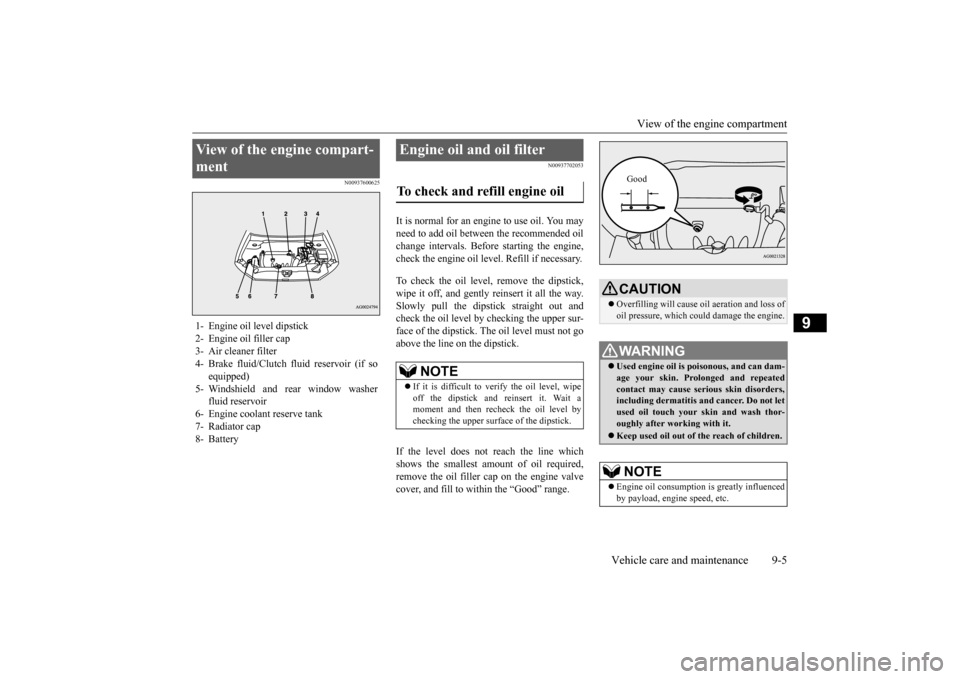
View of the engine compartment
Vehicle care and maintenance 9-5
9
N00937600625
N00937702053
It is normal for an engi
ne to use oil. You may
need to add oil between the recommended oilchange intervals. Before starting the engine, check the engine oil level. Refill if necessary. To check the oil level, remove the dipstick, wipe it off, and gently reinsert it all the way. Slowly pull the dipstick straight out andcheck the oil level by checking the upper sur- face of the dipstick. Th
e oil level must not go
above the line on the dipstick. If the level does not reach the line which shows the smallest amount of oil required, remove the oil filler cap on the engine valve cover, and fill to within the “Good” range.
View of the engine compart- ment 1- Engine oil level dipstick 2- Engine oil filler cap 3- Air cleaner filter4- Brake fluid/Clutch fluid reservoir (if so
equipped)
5- Windshield and rear window washer
fluid reservoir
6- Engine coolant reserve tank 7- Radiator cap 8- Battery
Engine oil and oil filter To check and refill engine oil
NOTE
If it is difficult to verify the oil level, wipe off the dipstick and reinsert it. Wait a moment and then recheck the oil level bychecking the upper surface of the dipstick.
CAUTION Overfilling will cause oil aeration and loss of oil pressure, which could damage the engine.WA R N I N G Used engine oil is poisonous, and can dam- age your skin. Prolonged and repeated contact may cause serious skin disorders, including dermatitis and cancer. Do not letused oil touch your skin and wash thor- oughly after working with it. Keep used oil out of the reach of children.NOTE
Engine oil consumption
is greatly influenced
by payload, engine speed, etc.Good
BK0206700US.bo
ok 5 ページ 2014年3月25日 火曜日 午後4時42分
Page 330 of 384

Engine coolant
Vehicle care and maintenance 9-7
9
require that the filter can withstand a pressure of 256 psi (1.8 MPa). A Genuine Mitsubishi oil filter is the best replacement filter. Follow the installation
instructions printed on
the filter.
N00937800584
The engine coolant reserve tank (A) lets you quickly see when you need to add coolant. When the engine is cold, the level of the cool-ant in the reserve tank should be between the FULL and LOW marks. The radiator usually stays full so there is no reason to remove theradiator cap (B) except when you check the coolant freeze point or replace the antifreeze coolant.
Mitsubishi Motors Genuine Coolant provides excellent protection against corrosion andrust formation on all metals, including alumi- num, and prevents clogs in some parts of the engine.If you need to add co
olant often, or if the
level in the reserve tank does not drop when the engine cools, the cooling system shouldbe pressure-tested for leaks. Take your vehi- cle to an authorized
Mitsubishi Motors dealer
or a repair facility of your choice for testing.
The radiator cap must be tight sealed to pre- vent losing coolant, which may result in engine damage. Only use a GenuineMitsubishi Parts radiator cap, or an approved equivalent.
Engine coolant To check the coolant level
FULL LOW
To add coolant Use “Mitsubishi Motors Genuine Super LongLife Coolant Premium” or equivalent
*.
* : similar high quality ethylene glycol based non-silicate, non-amine, non-nitrate and non-borate coolant with long life hybrid organic acid technologyCAUTION Do not use alcohol or methanol antifreeze or any engine coolants that contain them. Using the wrong antifreeze can corrode aluminum parts.
The required concentration of anti-freeze dif- fers depending on the expected ambient tem- perature. Above -31 °F (-35 °C) : 50 % concentration of anti-freezeBelow -31 °F (-35 °C) : 60 % concentration of anti-freeze You can check the concentration level with agauge from an automotive supply store, or your authorized Mitsubishi Motors dealer or service station can check it for you. Do not use water to adjust the concentration of coolant. Do not top off the tank with plain water only. Water by itself boils at a lower temperatureand does not stop rust or freezing. If the water freezes, it will damage your cooling system. Do not use tapwater. It can causecorrosion and rust.
Radiator cap
CAUTION
BK0206700US.bo
ok 7 ページ 2014年3月25日 火曜日 午後4時42分
Page 331 of 384
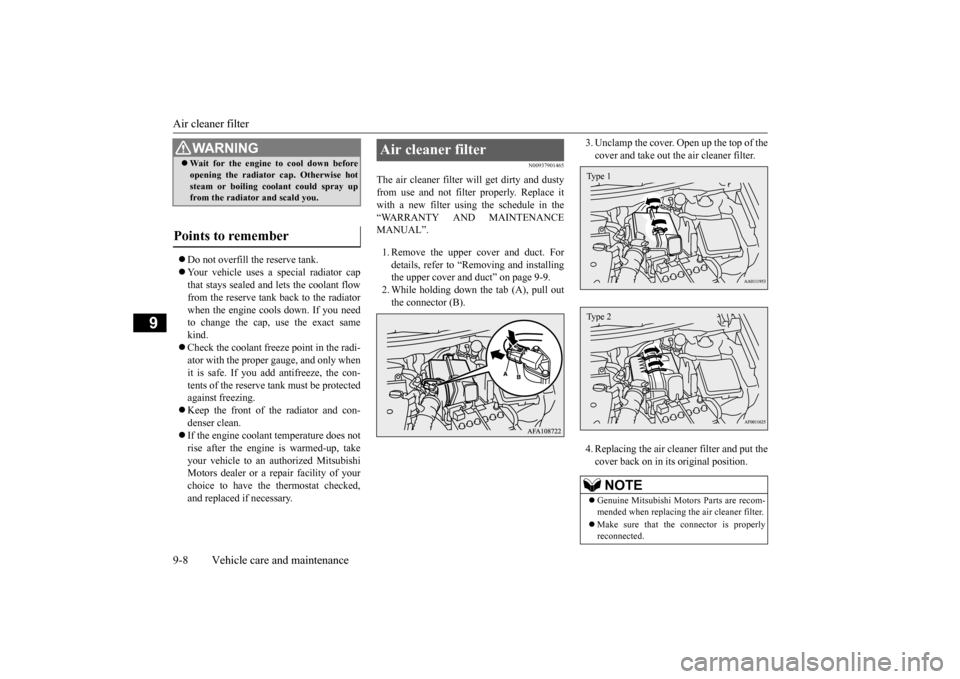
Air cleaner filter 9-8 Vehicle care and maintenance
9
Do not overfill the reserve tank. Your vehicle uses a special radiator cap that stays sealed and lets the coolant flow from the reserve tank back to the radiatorwhen the engine cools down. If you need to change the cap, use the exact same kind. Check the coolant freeze point in the radi- ator with the proper gauge, and only when it is safe. If you add antifreeze, the con-tents of the reserve tank must be protected against freezing. Keep the front of the radiator and con- denser clean. If the engine coolant temperature does not rise after the engine is warmed-up, takeyour vehicle to an authorized Mitsubishi Motors dealer or a repair facility of your choice to have the thermostat checked,and replaced if necessary.
N00937901465
The air cleaner filter w
ill get dirty and dusty
from use and not filter properly. Replace itwith a new filter using the schedule in the “WARRANTY AND MAINTENANCE MANUAL”. 1. Remove the upper cover and duct. For details, refer to “Removing and installingthe upper cover and duct” on page 9-9. 2. While holding down
the tab (A), pull out
the connector (B).
3. Unclamp the cover. Open up the top of the cover and take out the air cleaner filter. 4. Replacing the air cleaner filter and put the cover back on in its original position.
WA R N I N G Wait for the engine to cool down before opening the radiator cap. Otherwise hot steam or boiling coolant could spray up from the radiator and scald you.
Points to remember
Air cleaner filter
NOTE
Genuine Mitsubishi Moto
rs Parts are recom-
mended when replacing the air cleaner filter. Make sure that the connector is properly reconnected.Type 1Type 2
BK0206700US.bo
ok 8 ページ 2014年3月25日 火曜日 午後4時42分
Page 332 of 384
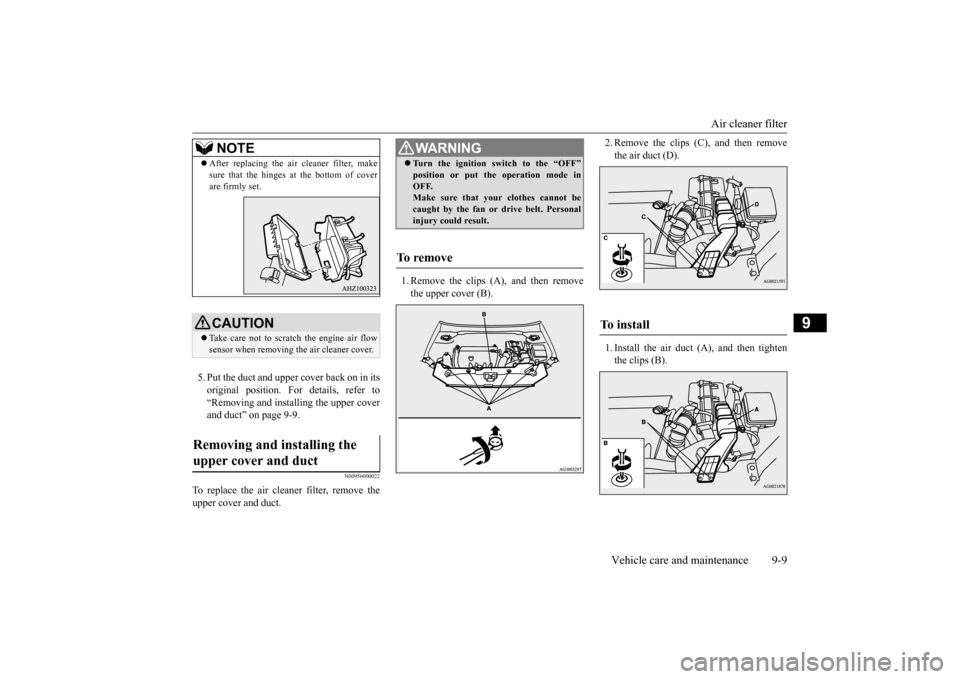
Air cleaner filter
Vehicle care and maintenance 9-9
9
5. Put the duct and upper cover back on in its original position. For details, refer to “Removing and installing the upper cover and duct” on page 9-9.
N00956000022
To replace the air cleaner filter, remove theupper cover and duct.
1. Remove the clips (A), and then remove the upper cover (B).
2. Remove the clips (C), and then remove the air duct (D). 1. Install the air duct
(A), and then tighten
the clips (B).
After replacing the air cleaner filter, make sure that the hinges at the bottom of cover are firmly set.CAUTION Take care not to scratch the engine air flow sensor when removing the air cleaner cover.
Removing and installing the upper cover and duct
NOTE
WA R N I N G Turn the ignition switch to the “OFF” position or put the operation mode in OFF. Make sure that your clothes cannot be caught by the fan or drive belt. Personalinjury could result.
To remove
To install
BK0206700US.bo
ok 9 ページ 2014年3月25日 火曜日 午後4時42分
Page 378 of 384

Alphabetical index
12-1
12
Numerics
4-wheel drive operation
.......................
5-58
A
Accessory (installation)
.........................
3-6
Active stability control (ASC)
..............
5-68
Air bag
......................
........................
4-26
Air cleaner filter
...................
................
9-8
Air conditioning
Automatic air conditioning
.....
7-14
, 7-20
Important air conditioning operating tips
..
7-25Manual air conditioning
.............
7-4
, 7-9
Air purifier
....................
.....................
7-25
Aluminum wheels
...............................
9-42
AM/FM radio
....................
.................
7-26
Antenna
Roof antenna
.................
.................
7-58
Anti-lock braking system
.....................
5-65
Arm rest
........................
.......................
4-7
Assist grip
.....................
...................
5-169
Audio
AM/FM radio
................
.................
7-26
CD player
.....................
.................
7-26
Troubleshooting
.............................
7-56
Automatic air conditioning
.........
7-14
, 7-20
Automatic transaxle
Fluid
.......................
......................
11-5
B
Back-up light
Bulb capacity
..................
...............
9-29
Replacement
...................
...............
9-36
Ball joint, steering linkage seals and drive shaft boots
.....................
..................
9-23
Battery
........................
......................
9-12
Charging system warning light
.......
5-119
Disconnection and connection
.........
9-12
During cold weather
.......................
9-12
Specification
...................
...............
11-4
Bluetooth 2.0 interface
.......................
5-135
Bottle holders
...................
.................
5-168
Brake
Fluid
.......................
......................
11-5
Brake assist system
.............................
5-64
Braking
.......................
........................
6-5
Anti-lock braking system
................
5-65
Hose
.......................
......................
9-23
Pad wear alarm
...............
...............
5-63
Parking brake
..................
...............
5-40
Pedal
.......................
......................
5-62
Pedal free play
................
...............
9-20
Power brakes
..................
...............
5-62
Service brake
..................
...............
5-62
Warning lights
..............................
5-118
Break-in recommendations
....................
5-3
Bulb capacity
.....................
.................
9-29
C
California Perchlorate Materials Requirements
.....................
................
3-6
Capacities
.....................
.....................
11-5
Card holder
...................
...................
5-160
Cargo area cover
................
...............
5-168
Cargo loads
...................
.....................
6-10
Cargo room light
Bulb capacity
................
.................
9-30
Catalytic converter
................
................
9-2
Cautions on the handling of all-wheel drive vehicles
.......................
.....................
5-61
CD player
......................
.....................
7-26
Certification label
...............................
11-3
Charging system warning light
...........
5-119
Child restraint systems
........................
4-18
Child safety locks for rear door
............
5-31
Cleaning
Inside of your vehicle
......................
9-38
Outside of your vehicle
...................
9-40
Clutch
Pedal free play
...............
.................
9-20
Coat hook
......................
...................
5-169
Consumer information
.........................
10-2
BK0206700US.bo
ok 1 ページ 2014年3月25日 火曜日 午後4時42分